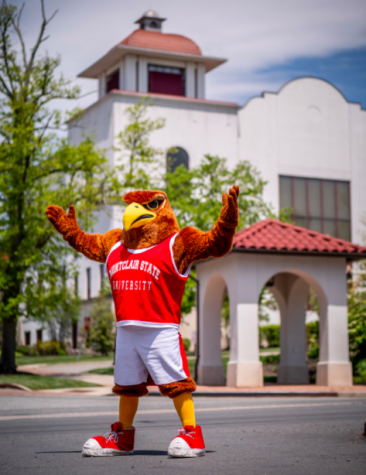contributed by Mike Peters, Montclair State University Director of Photographic Services
An aerial view of the Montclair State University campus. Montclair State University is one of many colleges to move away from using an Indian mascot.
Colleges’ actions regarding Indian mascot controversies
January 27, 2021
 Pascack Valley is not alone in facing controversy its Indian mascot. Many well-known colleges have gone through similar experiences, sporting Native American derived mascots before moving away from them. On the other hand, a handful of colleges with Indian mascots have been allowed to maintain their nicknames with permission from the given tribe that they have taken their mascot from. One of the few colleges that have kept its mascot is the University of Utah, which has been able to maintain its mascot, Swoop, with permission from the Ute tribes. In this installment of the “What’s in a Name?” coverage package, Staff Editor Abby Shapiro explores how the University of Utah was able to sustain their mascot, while Staff Writer Sarah Shapiro explores the decisions of Montclair State University and Syracuse University to change their mascots.
Pascack Valley is not alone in facing controversy its Indian mascot. Many well-known colleges have gone through similar experiences, sporting Native American derived mascots before moving away from them. On the other hand, a handful of colleges with Indian mascots have been allowed to maintain their nicknames with permission from the given tribe that they have taken their mascot from. One of the few colleges that have kept its mascot is the University of Utah, which has been able to maintain its mascot, Swoop, with permission from the Ute tribes. In this installment of the “What’s in a Name?” coverage package, Staff Editor Abby Shapiro explores how the University of Utah was able to sustain their mascot, while Staff Writer Sarah Shapiro explores the decisions of Montclair State University and Syracuse University to change their mascots.
Colleges remove Indian mascots
During a division III baseball championship in 1987, Montclair State University sported caps adorned with a “cartoon native character.” This event took place two years before the school switched its nickname to the Red Hawks.
In 2005, the NCAA sent out a press release banning the use of inappropriate signs or displays of racial and ethnic mascots in the NCAA colleges. Walter Harrison, Chair of the Executive committee said, “Colleges and universities may adopt any mascot that they wish, as that is an institutional matter. But, as a national association, we believe that mascots, nicknames or images deemed hostile or abusive in terms of race, ethnicity or national origin should not be visible at the championship events that we control.”

The Montclair State University mascot, Rocky the Red Hawk. In 1989, the school changed its nickname form the Indians to the Red Hawks.
Montclair State University’s first athletic logo was used from the 1920s to 1930s. On Montclair States’ athletic uniforms, it read the “Big Reds.” Then, in the 1930s the Teacher’s College at Montclair State changed its nickname to the Indians. The picture of the Indian mascot appeared on the Montclair State athletic uniforms.
“Very few students know about it because it is not something that the school talks about,” Professor of Religion at Montclair State University, Mark Clatterbuck, said.“It’s hard to find anything on the website [about the school’s former mascot].”
Later, in 1989, the athletic department at Montclair State chose to replace the Indian mascot with the Red Hawks – the birds that occupied the surrounding areas of the campus. It chose to change the mascot due to the impact it made on the Native Americans in the surrounding area.
A contest was created to replace the Indian logo with an alternative picture. Eventual winner Maureen Mcgill, a student at Montclair State, depicted a logo of a Red Hawk soaring under an “M.”
Similarly, in 1951 a bronze statuette of the Saltine Warrior, a Native American figure, was placed on the Syracuse University campus, where it stayed for many years. Many believed it to be an emblem of pride.
The origin of the Saltine Warrior was from a tale of Hoschenegada, that was later proven untrue, translated to the name of “The Salt Warrior.” The remains of the Onondaga Nation chief, Ogeekeda Hoschenegada was said to be found in the 1920s during the excavation of the Syracuse Women’s Building.
After an article was posted in a campus magazine, “The Orange Peel,” it generated attention and led to the university making the Saltine Warrior its new mascot.
Then, during the 1950s a fraternity decided to dress up as the Saltine Warrior and parade it around at a football game. In the stadium, people from the crowd shouted battle cries.
When Doug George Kanentiio, a member of the Mohawk nation and Vice President for the Hiawatha Institute of Indigenous Knowledge, visited Syracuse University, he was shocked by the use of the Saltine Warrior mascot. Then, Kanentiio had a discussion with Chancellor Melvin Eggers in 1977 about the mascot.
He agreed to take strides to remove the university’s mascot. Later, Mr. Kanentiio had a discussion with the fraternity that dressed up as the mascot in hopes of the young men understanding where he was coming from.
After 1978, the Saltine Warrior was retired as the Syracuse Mascot. The orange was known by many as the unofficial mascot of Syracuse for a period of time. As of 1995, Otto the Orange was named the Syracuse University mascot.
University of Utah preserves Indian nickname
Ute tribal member Cameron Cuch said that while there is a lot of controversy surrounding Native American mascots, he has always seen his tribe’s relationship with the University of Utah as a positive thing. Throughout the years, Cuch has found that the university has been able to maintain a great professional relationship with the Ute tribe.
According to The University of Utah’s website, the university must get approval from the Ute tribe before presenting anything that has to do with the Ute Indians to the public’s eye. The university uses “Ute” as its nickname and “Swoop,” which depicts a red letter ‘U’ with white and red feathers, as its mascot. The mascot represents the red-tailed hawk, which is indigenous to Utah.
“One of the main things that the Ute tribe wants help with is to explain to our students, fans, alumni, and the public in general who the Utes are,” Fred Esplin, University of Utah Adjunct Associate Professor and liaison to the Ute tribe, said.
“What is a Ute?,” explained that the Utes have allowed the University of Utah’s athletic teams to be called “The Utes” as a sign of respect.
Following many years of utilizing the Ute nickname, Esplin said that the tribe is now featured during University of Utah sporting events, including football.
“They come to one of our football games during the Native American month [of November] and they do a drum circle and dance with one hundred people, young and old,” Esplin said. “Dancing in their tribal wear and performing is something that is very important to them.”
The university’s website explains that the Utes have appointed one tribal member, Cuch, to be a “messenger” between the tribe and the university to assist the school with its campaign.
“You have a sovereign tribal nation and an institution like the University of Utah that come together to form a formal agreement for the use of the name and for there to be educated about the Ute tribe which is part of that agreement,” Cuch said.
